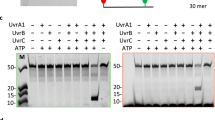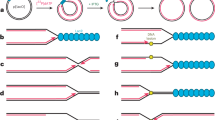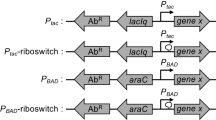Abstract
A new tool for probing the regulation of non-essential gene products has recently been developed1—this is a derivative of bacteriophage Mu into which the Escherichia coli genes for lactose metabolism have been fused (referred to here as Mu(lac, amp)). The DNA of this defective virus can insert randomly into the chromosome of a cell and mutants canbe retrieved in which the β-galactosidase gene carried on the phage is under the control of the regulatory elements of the operon in which it now resides.We used this phage to generate DNA repair-deficient mutants, one of which washighly UV-sensitive due to insertion of the Mu(lac, amp) into the uvrB regionof the chromosome. When exposed to UV light, this strain produces β-galactosidase at a much greater rate than unexposed cells. This suggests that the uvrB operon is inducible. These results were initially rather surprising. Although various components of the enzyme systems involved in Weigle-reactivation2,3, post-replication repair4–6 and repair of alkylation damage7,8 had been established as inducible, the products of the uvrA, uvrB and uvrC genes which collectively effect nucleotide excision repair9–11, seemed to be firmly established as a constitutively synthesized repair system. This conclusion was drawn because the activity of these enzymes can be easily detected in uninduced cells9–11; and mutations in the genes recA and lexA, which affect the regulation of most of the inducible repair systems12, have relatively little effect on uvrA, uvrB -mediated excision repair13. Thus the uvrA and uvrB gene products seemed to be produced constitutively at maximal or near maximal rates. However, recent reports suggest a role for the uvrA and uvrB gene products in various inducible repair systems6,14–17. Because these studies all relied on indirect measurements of induction, it could never be determined if the results reflected induction of other components of these systems or if the uvrA or uvrB gene products themselves were regulated. The insertion mutant described here allowed us to monitor expression of the uvrB operon directly and provided evidence for regulated synthesis of the uvrB gene product.
This is a preview of subscription content, access via your institution
Access options
Subscribe to this journal
Receive 51 print issues and online access
$199.00 per year
only $3.90 per issue
Buy this article
- Purchase on Springer Link
- Instant access to full article PDF
Prices may be subject to local taxes which are calculated during checkout
Similar content being viewed by others
References
Casadaban, M. J. & Cohen, S. N. Proc. natn. Acad. Sci. U.S.A. 76, 4530–4533 (1979).
Defais, M., Fauquet, P., Radman, M. & Errera, M. Virology 43, 495–503 (1971).
Defais, M., Caillet-Fauquet, P., Fox, M. S. & Radman, M. Molec. gen. Genet. 148, 125–130 (1976).
Sedgwick, S. G. Proc. natn. Acad. Sci. U.S.A. 72, 2753–2757 (1975).
Youngs, D. A. & Smith, K. C. J. Bact. 125, 102–110 (1976).
Ganesan, A. K., Seawell, P. C., Mount, D. W. J. Bact. 135, 935–942 (1978).
Samson, L. & Cairns, J. Nature 267, 281–282 (1977).
Jeggo, P., Defais, M., Samson, L. & Schendel, P. Molec. gen. Genet. 157, 1–9 (1977).
Braun, A. & Grossman, L. Proc. natn. Acad. Sci. U.S.A. 71, 1838–1842 (1974).
Braun, A. G., Radman, M. & Grossman, L. Biochemistry 15, 4116–4120 (1976).
Seeberg, E. Proc. natn. Acad. Sci. U.S.A. 75, 2569–2573 (1978).
Witkin, E. M. Bact. Rev. 40, 869–907 (1976).
Howard-Flanders, P. & Boyce, R. P. Radiat. Res. Suppl. 6, 156–184 (1966).
Mount, D. W., Kosel, C. K. & Walker, A. Molec. gen. Genet. 146, 37–41 (1976).
Clark, A. J. & Volkert, M. R. in DNA Repair Mechanisms (eds Hanawalt, P. C., Friedberg, E. C. & Fox, C. F.) 57–72 (Academic, New York, 1978).
Rothman, R. H., Margossian, L. J. & Clark, A. J. Molec. gen. Genet. 169, 279–287 (1979).
Walker, G. C. & Dobson, P. P. Molec. gen. Genet. 172, 17–24 (1979).
Cuzin, F. & Jacob, F. C.r. hebd. Séanc. Acad. Sci., Paris 258, 1350–1352 (1964).
Howard-Flanders, P., Boyce, R. P. & Theriot, L. Genetics 53, 1119–1136 (1966).
Kato, T., Rothman, R. H. & Clark, A. J. Genetics 87, 1–18 (1977).
Bachmann, B. J. & Low, K. B. Microbiol. Rev. 44, 1–56 (1980).
Miller, J. H. in Experiments in Molecular Genetics (Cold Spring Harbor Press, New York, 1972).
Rupp, W. D., Sancar, A., Kennedy, W. J., Ayers, J. & Griswold, J. in DNA Repair Mechanisms (eds Hanawalt, P. C., Friedberg, E. C. & Fox, C. F.) 229–235 (Academic, New York, 1978).
Elespuru, R. K. & Yarmolinsky, M. B. Envir. Mutat, 1, 65–78 (1979).
Kenyon, C. J. & Walker, G. C. Proc. natn. Acad.Sci. U.S.A. 77, 2819–2823 (1980).
Author information
Authors and Affiliations
Rights and permissions
About this article
Cite this article
Fogliano, M., Schendel, P. Evidence for the inducibility of the uvrB operon. Nature 289, 196–198 (1981). https://doi.org/10.1038/289196a0
Received:
Accepted:
Issue Date:
DOI: https://doi.org/10.1038/289196a0
This article is cited by
-
The Nobel Prize in Chemistry 2015: Exciting discoveries in DNA repair by Aziz Sancar
Science China Life Sciences (2016)
-
Identification of Vibrio natriegens uvrA and uvrB genes and analysis of gene regulation using transcriptional reporter plasmids
The Journal of Microbiology (2010)
-
Analysis of the regulatory elements of the Escherichia coli uvrC gene by construction of operon fusions
Molecular and General Genetics MGG (1988)
-
Transcriptional regulation of DNA damage responsive (DDR) genes in different rad mutant strains of Saccharomyces cerevisiae
Molecular and General Genetics MGG (1986)
-
UV-inducible proteins in Saccharomyces cerevisiae
Current Genetics (1985)
Comments
By submitting a comment you agree to abide by our Terms and Community Guidelines. If you find something abusive or that does not comply with our terms or guidelines please flag it as inappropriate.



